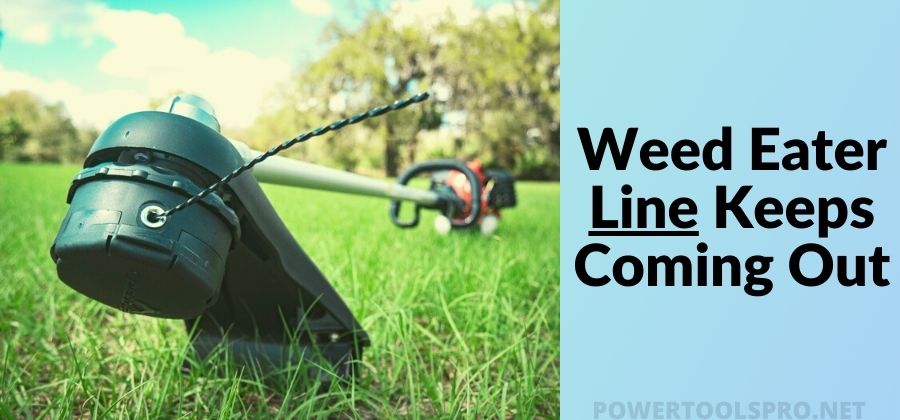
Are you tired of thinking about why does my weed eater line keeps coming out? And don’t know how you should prevent this issue? Then stay with me and find out the solution to your problem. We have highlighted and resolved the most common issues that result in leading the string out of the weed eater. If you are a gardener or love to do gardening, then you must have gone through this weed eater line issue while working in the yard.
We have gathered all the easy solutions for you. So, anyone can now fix this weed eater problem by himself. Here are some of the problems that cause eater lines to slip out and their solutions. We have considered all of them.
What is a Weed Eater (String Trimmer) Line?
A weed eater is a gardening tool used to mow down weeds, herbs, and ground cover. It comprises different parts. One of its basic parts is the weed eater line.
A weed eater line, also known as a weed whip, is a line made of monofilament. It is wound around a spool and fixed inside its head. This string works more effectively than a blade and cuts off all the weeds.
Possible Factors that Cause Weed Eater Line to Keep Coming Out
Following are some reasons that can cause a weed wacker line to keep coming out:
1. Malfunctioning Head:
A trimmer head is an assembly of different parts. Any malfunctioning in any of its parts results in overfeeding of the weed eater line. The head becomes defective when you use multiple trimmer attachments. Every attachment is for a different purpose. So, when you use the wrong one, the head-the was worn out and doesn’t work properly.
Another reason why weed eater string keeps coming out is using the wrong trimmer head size. This will cause the string line to become tangled or stuck. Moreover, bumping can cause the eyelets of string to break off. Thus, the string comes out.
2. Worn Out Head Cap:
The Head cap keeps all the parts of the lawn trimmer head locked in place. Thus, the worn-out head cap can cause the line to come out. When you bump the head on the ground for feeding the line it’s the cap that faces the ground. Thus, excessive bumping can cause the head cap to wear out. Moreover, the head cap is locked using tabs. These tabs can break out or become loose. Thus, the cap does not fit properly on the head. Also, sometimes debris gets inside the cap.
3. Impaired Spool:
An impaired spool can cause the lined-up string to become loose. The string is wound firmly on the spool. An oversized spool can cause the string to lose its firmness. So that’s the reason that the trimmer line keeps feeding out.
Moreover, winding the string on the spool also causes overfeeding. Many users don’t know how to wind up the string and in what direction. Winding it in the wrong direction can cause malfunctioning. The string is always winded in the clockwise or forward direction. It also keeps the string tightened. However, winding the string in an anti-clockwise or backward direction causes the string to become loose.
Another reason for impaired spool is that oversized or tight spools are either over loose or over tightened. Thus, causing malfunctioning of the eater’s line.
4. Glitch in Weed String:
The string is the prime part of a weed whip. Any changes in its function result in a broken eater. So, you need to check it completely. Strings come in different sizes and shapes. All of them are used for different purposes. When you use one type of string to perform the function of another type of string. It will cause glitches in the string. Not wrapping the string correctly causes disruptions.
5. Loose Head Spring:
The head spring applies pressure to the spool and leveler on the eater, preventing the spool from moving. If the spring is loose or tightened so much, it results in overfeeding of the string. Moreover, excessive use, high-speed functioning, and high fixation also cause spring to become loose. Sometimes high-speed functioning also causes spring to move out of place. Thus, you should check the spring properly.
How to Avoid a Weed Eater Line from Coming Out?
Avoiding a weed eater line from coming out, can be done by using one of these solutions regarding the problem with the eater:
1. Use a Good Head:
To keep the head from malfunctioning, you should not use different trimmers again and again. Only use the trimmer head that suits the head and avoid changing it. Every company has its trimmer size. Although, it’s not mentioned all the time. So, try to use the head that fits your trimmer smoothly. Don’t try to use one company’s trimmer head on the other. Moreover, try to avoid over bumping to prolong your trimmer’s life. Also, check every part of the head before use to avoid malfunctioning. If your bumper head is not working properly, replace it with a new one.
2. Use a Stable Head Cap:
For keeping the string in its place, you should not use a worn-out cap. Try to check the cap by opening its tab. If the tabs are loose or if they are broken. Replace them. Furthermore, do not use too much force when pushing the bumper head cap against the ground. Try to use it smoothly and steadily. To change the cap, open it using the tabs and place the same size cap. Do not use oversized caps.
3. Choose a Suitable Spool:
The spool is probably the most important part that keeps the string in its place. So, use a suitable spool that fits on the head spring properly. To avoid spool from coming out of the spring. Also, try to wrap the string on the spool in a forward direction. If you notice any malfunctioning in the spool. Open up the head cap. Remove the spool and put another one in its place.
4. Choose the Right String:
To avoid the string from coming out, you should use a suitable string for every purpose. For instance, the most common string is round. However, it is not effective for cutting large weeds. So, you can use a sharp-shaped string instead. Some of the sharp-shaped strings are star-shaped and square-shaped with pointed ends. If your string is not suitable. Change it and wrap it in a direction. Always try to wrap it normally, neither tight nor loose.
5. Using a Fixed Spring:
Using the right size of the string will help the eater to keep the leveler in place. The pressure on the leveler is so important in avoiding the string from coming out. If the string is in place, then the leveler will work smoothly and there will be no issue. If your eater’s spring is not working properly. Remove the cap and spool. Take the loose spring out and replace it with a new one. Remember to keep the tightened side of the spring down and the loose side on top.
Recommended String Trimmers with Durable String Line
1) Electric Cordless String Trimmer
2) Worx 12 Inch 20 Volt Grass Trimmer
Best String Lines for Your String Trimmer:
1) Cyclone Desert Extrusion
2) Oregon 20-020 Magnum Gatorline Supertwist
3) Maxpower 333695 Residential Grade Round
4) Oregon 22-855 Heavy-Duty Professional Magnum
How to String a Weed Eater (Weed Whacker) in a Simple way?
To string a weed eater, open the cap of the eater by pressing each of the tabs. After it is opened, make sure that the inside is clean. Now, remove the sloop. Take a durable string and cut the desired amount of string that is suitable for your weed eater. The string mostly ranges from 10 to 20 feet. After cutting, hold the spool in your hand. After holding it, you can see the hole in the spool where the string is winded. Put the string into this hole.
After putting it in the hole, start winding the string in the opposite direction to yourself (i.e., in a forward direction). After you have left with a one-foot string, stop winding. Now put the remaining part of the string into the two eyelets on the head. In this way, you will connect the spool with the head of the eater. Now put the cap in place. So, here is the most simple way of winding.
Conclusion
Weedeater line slipping is the common problem garden enthusiasts are facing these days. Whether the cause of the problem is different, it is doing the same harm. So, must try to use our effective solutions and start using the weed eater properly. If you face any problems, just check your device and try to replace its parts. We will hope that you find the solution to your problem after reading our post.
